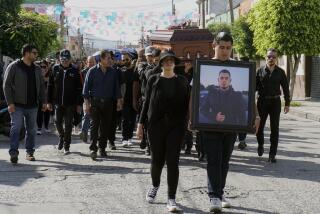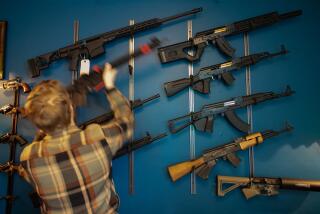In El Paso and now Dayton, the familiar fallout of a mass shooting repeats again

The bodies still lay in the aisles of Walmart. Police officials in this border city had yet to release the 20 victims’ names, adding them to the long list of mass-shooting casualties in this gun-rich country. Only 12 hours and 35 minutes had elapsed.
And then, another gunman opened fire on another crowd in another U.S. city, leaving another set of grief-stricken loved ones. On Saturday, it was El Paso: 20 dead, 26 injured. On Sunday it was Dayton, Ohio: 9 dead, 27 injured.
As is so often the case, the suspects were twenty-something white men, their weapons, assault-style rifles. As is also too often the case, blame flew in all directions: Easily accessible guns. A mental health crisis. White nationalists spreading hatred. A president who rallies supporters with racist rants. A 24/7 digital culture run amok.
And another mayor joined an increasingly crowded club.
“Honestly, and I have to say unfortunately, because we have had so many of these incidences, there is a bevy of mayors who are able to give great advice and feedback,” Dayton Mayor Nan Whaley said during a Sunday afternoon briefing. “I think that’s quite frankly a little sad, if you think about it, that they’ve learned so much because all of their communities have gone through these terrible mass shootings.”
She called the deaths in her city “completely preventable,” in an earlier phone interview with NBC’s “Meet the Press.” “We’re city No. 250,” she said. “How many more cities have to go through mass shootings before somebody does something to change the law?”
Although authorities still have not formally identified the suspect in the El Paso Walmart shooting, his name has been widely reported as Patrick Crusius, 21, from the Dallas suburb of Allen, Texas. El Paso jail records show a Patrick Wood Crusius was booked Sunday on state charges of capital murder.
And on Sunday, FBI agents served search warrants at three Dallas-area locations, Special Agent Jeanette Harper, a spokeswoman for the agency’s El Paso Division, said at a Sunday evening briefing.
Authorities have tentatively linked Crusius to a manifesto posted online shortly before the shooting that railed against an “invasion” of Latino migrants, particularly in Texas.
Federal prosecutors are investigating the El Paso shooting as a hate crime and an act of domestic terrorism and plan to seek the death penalty, according to John Bash, U.S. attorney for the Western District of Texas.
“We’re going to do what we do to terrorists in this country — deliver swift and certain justice,” Bash said at a briefing in El Paso early Sunday.
By late Sunday, officials had yet to release a list of the shooting victims. Social media bubbled with GoFundMe requests. There were posts beseeching anyone with information about their loved ones to get in touch. And sometimes there was bad news.
On Facebook Saturday afternoon, Vielka Yu pleaded for information about her grandparents, who had been shopping at Walmart and the nearby Cielo Vista Mall when the shooting broke out. About 24 hours later, came the update:
Ya recibimos noticias, lamentablemente malas … mis abuelos fallecieron, acaban de confirmar.
We have received the news, unfortunately bad … my grandparents passed away, they just confirmed.
The morning after the shooting, St. Pius X Catholic Church was packed. At least one of the families affected by the tragedy belongs to the parish. Early morning sun streamed through a stain-glassed window. Outside, two friars sat quietly.
The Rev. Cong Vo asked for a long moment of silence at the beginning of Mass and, during his homily, prayed to “keep us from the weapons of hate.”
“We have God. We have faith. We have one another,” Vo said. “Be not afraid … have hope, not despair.”
The fallout from Saturday’s shooting appeared in several places across El Paso. Billboards along Interstate 10 already read “El Paso Strong.” There was still yellow police tape around the Walmart where the shooting took place, and a small memorial was growing with flowers, crucifixes and votives.
Gloria Guillen and her husband, Arturo Guillen, arrived at the memorial site between Walmart and Hooters and placed flowers. Gloria said she hadn’t wanted to come, because she’d had surgery on her leg and was afraid the big bandage would spark speculation. She wasn’t a shooting victim; she’d had surgery Saturday to remove a cyst.
The couple has lived in El Paso for more than four decades. As she started to place the flowers on the memorial, she began to choke up. They held hands.
Their children, Gloria said, live in California and they fear for their parents here on the border. “They called us and told us not to go out,” said Gloria, 60.
Six Mexican nationals were killed in the El Paso shooting, and on Sunday Mexico’s foreign minister said that his country plans to take legal action against whoever sold the gun used by the suspect. Marcelo Ebrard said that “it’s urgent that we take corresponding actions against weapons.”
Ebrard has frequently blamed the flood of illegal weapons from the United States into Mexico, where guns are highly restricted, as a factor in Mexico’s rising rate of violent crime. He called the shooting “a terrorist act.”
In Dayton, Police Chief Richard Biehl said that officers were patrolling a popular entertainment district early Sunday at closing time for local bars when they heard gunshots and saw a crowd running from the gunfire.
“They engaged the suspect, who was actively firing and attempting to enter a crowded liquor establishment,” Biehl said during a Sunday briefing. The “threat was neutralized in approximately 30 seconds of the suspect firing his first shots.”
Biehl identified the suspect, who was killed by police, as Connor Stephen Betts, 24. Betts’ only previous run-ins with police had been traffic incidents.
Betts drove to Dayton’s Oregon District in a gray 2007 Toyota Corolla with his sister, Megan Betts, 22, and a friend. He separated from the other two sometime during the evening, Biehl said. During that time, he donned a bulletproof vest and a mask, got an assault-style weapon with magazines holding 100 rounds of ammunition and began shooting.
The second person he killed was his sister.
Biehl said Betts had ordered the weapon online from Texas but picked it up at a local firearms dealer. He also bought a shotgun from a separate local dealer. Both guns had been purchased legally, Biehl said.
The police said it was unclear whether Betts targeted his sister or whether he had been influenced by the El Paso shooting.
“We are very, very early into this investigation,” Biehl said. “Any suggestion at this time of motive would be irresponsible. We do not have sufficient information to answer the question that everyone wants to know: Why?”
At a briefing earlier in the day, Ohio’s two senators — Democrat Sherrod Brown and Republican Rob Portman — outlined what have become the default explanations of the left and right for the gun violence that has plagued the U.S.
Brown decried what he said was the nation’s inability to act on critical gun control legislation. Portman bemoaned a growing mental health crisis.
Brown: “Our first response of course is sadness and hearts and prayers and thoughts for families and the community and police and fire.... My next thought was anger at our country and society and our Congress for not doing anything about this.”
Portman: “No law can correct the more fundamental cultural problems that we face today as a country. The shooting last night is an indication of that.... We have to look deep into our hearts and figure out how could someone point a gun at someone he had never seen or known and pull the trigger.”
Speaking to reporters on a tarmac in New Jersey on Sunday after a weekend at his golf club in Bedminster, President Trump took the mental health crisis tack.
“We have done a lot but perhaps more has to be done,” Trump said. “This is also a mental illness problem. If you look at both cases, these are people who are very seriously mentally ill.”
Of gun violence in general, he said, “We have to get it stopped. It’s been going on for years, years and years in our country.”
Trump would get no argument on that point from Adam Lankford, a criminology professor at the University of Alabama.
Lankford said mass shootings in the U.S. have gotten deadlier over time. According to his research, the average number of people killed in mass shootings has gone up 40% in the last decade compared to 1966 through 2009. Lankford pinned the blame for the increase in severity on the fact that more perpetrators are seeking fame and attention.
“The perpetrators recognize that if they kill more they’ll get more media attention and that they’ll generate more interest online,” Lankford said. Another reason, he said, is a competitive element among some attackers.
The U.S. also has far more mass shootings than the rest of the world. According to Lankford, one reason is that the U.S. has so many more firearms than other countries and it is easier to buy them here than elsewhere.
“We have more than 200 million more firearms than the next highest country,” Lankford said.
Times staff writers La Ganga and Etehad reported from Los Angeles, Hennessy-Fiske from Houston and Montero from El Paso. Staff writer Matthew Ormseth in Los Angeles contributed to this report.
More to Read
Start your day right
Sign up for Essential California for news, features and recommendations from the L.A. Times and beyond in your inbox six days a week.
You may occasionally receive promotional content from the Los Angeles Times.










